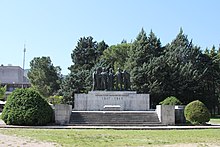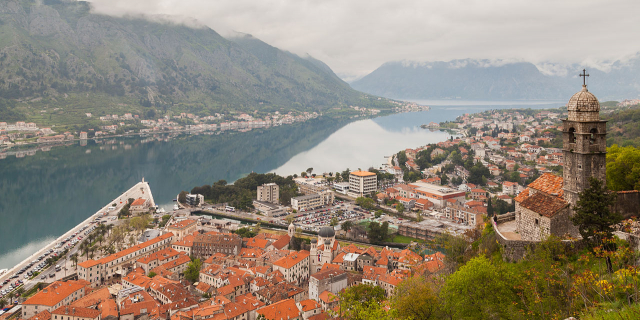Trebinje (Serbian Cyrillic: Требиње, pronounced [trěːbiɲe]) is a city and municipality in Republika Srpska, Bosnia and Herzegovina. It is the southernmost city in Bosnia and Herzegovina and is situated on the banks of Trebišnjica river in the region of East Herzegovina. As of 2013, it has a population of 31,433 inhabitants. The city's old town quarter dates to the 18th-century Ottoman period, and includes the Arslanagić Bridge, also known as Perovića Bridge.
 Serbian Orthodox Tvrdoš Monastery, founded in the 15th century.
Serbian Orthodox Tvrdoš Monastery, founded in the 15th century.De Administrando Imperio by Constantine VII (913–959) mentioned Travunija (Τερβουνια). Serbian Prince Vlastimir (r. 830–51) married his daughter to Krajina, the son of Beloje, and that family became hereditary rulers of Travunija. By 1040 Stefan Vojislav's state stretched in the coastal region from Ston in the north, down to his capital, Skadar, set up along the southern banks of the Skadar Lake, with other courts set up in Trebinje, Kotor and Bar.[1]
The town commanded the road from Ragusa to Constantinople, which was traversed in 1096 by Raymond IV of Toulouse and his crusaders.[2] Trebinje diocese has its episcopal seat in Polje near Trebinje.[3] At the end of the 12th century Stefan Nemanja conquered provinces that include Trebinje.[4] Under the name of Tribunia or Travunja it belonged to the Serbian Empire until 1355.[2] Trebinje became a part of the expanded medieval Bosnian state under Tvrtko I in 1373. There is a medieval tower in Gornje Police whose construction is often attributed to Vuk Branković. The old Tvrdoš Monastery dates back to the 15th century.
In 1482, together with the rest of Herzegovina (see: Herzog Stjepan Vukčić Kosača), the town was captured by the Ottoman Empire. The Old Town-Kastel was built by the Ottomans on the location of the medieval fortress of Ban Vir, on the western bank of the Trebišnjica River. The city walls, the Old Town square, and two mosques were built in the beginning of the 18th century by the Resulbegović family. The 16th-century Arslanagić bridge was originally built at the village of Arslanagić, 5 kilometres (3.1 mi) north of the town, by Mehmed-Paša Sokolović, and was run by Arslanagić family for centuries. The Arslanagić Bridge is one of the most attractive Ottoman-era bridges in Bosnia and Herzegovina. It has two large and two small semicircular arches.
Among noble families in the Trebinje region mentioned in Ragusan documents were Ljubibratić, Starčić, Popović, Krasomirić, Preljubović, Poznanović, Dragančić, Kobiljačić, Paštrović, Zemljić and Stanjević.[5]
Ottoman era
The burning of Saint Sava's remains after the Banat Uprising provoked the Serbs in other regions to revolt against the Ottomans.[6] Grdan, the vojvoda of Nikšić, organized revolt with Serbian Patriarch Jovan Kantul. From 1596, the center of anti-Ottoman activity in Herzegovina was the Tvrdoš Monastery in Trebinje, where Metropolitan Visarion was seated.[7] In 1596, the uprising broke out in Bjelopavlići, then spread to Drobnjaci, Nikšić, Piva and Gacko (see Serb Uprising of 1596–97). The rebels were defeated at the field of Gacko. It ultimately failed due to lack of foreign support.[7]
The hajduks in Herzegovina had in March 1655 carried out one of their greatest operations, raiding Trebinje, taking many slaves and carrying with them out much loot.[8]
On 26 November 1716, Austrian general Nastić with 400 soldiers and c. 500 hajduks attacked Trebinje, but did not take it over.[9] A combined Austro-Venetian-Hajduk force of 7,000 stood before the Trebinje walls, defended by 1,000 Ottomans.[9] The Ottomans were busy near Belgrade and with hajduk attacks towards Mostar, and were thus unable to reinforce Trebinje.[9] The conquest of Trebinje and Popovo field were given up to fight in Montenegro.[9] The Venetians took over Hutovo and Popovo, where they immediately recruited militarily from the population.[9]
Ottoman rule lasted from 1466 until 1878. The Trebinje region suffered especially in the 16th century, mostly from the hand of uskoks of Senj and various hajduk bands.[10] The calmer period during the Ottoman rule was the 18th century.[10] The Serb elders from Trebinje, together with the people of Nikšić, planned a great uprising in the summer of 1805, under the influence of the First Serbian Uprising. Their project was suppressed by the Ottoman pasha and probably with the help from the local Slavic Muslims.[10]
The Christians of Trebinje, together with the Montenegrins, fought against Napoleon's troops and in several conflicts they managed to defeat the French troops, such as the knife fight which took place on 2–3 October 1806 leaving several thousands of French soldiers dead, after which the French withdrew for a while.[10]
Notable participants in the Herzegovina Uprising (1852–62) from Trebinje include Mićo Ljubibratić.
During the Herzegovina Uprising (1875–77), the Bileća and Trebinje region was led by serdar Todor Mujičić, Gligor Milićević, Vasilj Svorcan and Sava Jakšić.
Austria-Hungary Austro-Hungarian soldiers hanging Serb civilians
Austro-Hungarian soldiers hanging Serb civiliansWith the Austro-Hungarian occupation of Bosnia and Herzegovina, many reforms took place. New administrative division was introduced and a large number of Austro-Hungarian troops were located in Trebinje, which was seen as a city of strategic value and position.[11] No factories or bigger investments were made in Trebinje during the AU rule.[11]
After the Assassination of Archduke Franz Ferdinand Croat-Muslim volunteer corps (German: Schutzcorp) terrorized Serb civilians of Bogojevići and other villages in Trebinje, which resulted in 83 children killed and 85 adults hanged.[12] Those and related actions resulted in migrations of the local population to Serbia.[13]
During the period of Austro-Hungarian administration (1878–1918), several fortifications were built on the surrounding hills, and there was a garrison based in the town. The imperial administrators also modernized the town, expanding it westwards, building the present main street, as well as several squares, parks, schools, tobacco plantations, etc.
SFR Yugoslavia (1945–92) Monument dedicated to the fighters who died during the struggle against fascism in 1941–1945
Monument dedicated to the fighters who died during the struggle against fascism in 1941–1945Trebinje grew rapidly in the era of Josip Broz Tito's Socialist Federal Republic of Yugoslavia between 1945 and 1980. It especially developed its hydroelectric potential with dams, artificial lakes, tunnels, and hydroelectric plants. This industrial development brought a large increase in the urban population of Trebinje.
Bosnian War (1992–95)Trebinje was the largest town in Serb-held eastern Herzegovina during the Bosnian War. It was controlled by Bosnian Serb forces from the fall of 1991, and was used as a major command and artillery base by Yugoslav People's Army (JNA) troops besieging the Croatian town of Dubrovnik. In 1992 Trebinje was declared the capital of the self-proclaimed Serbian Autonomous Region of Herzegovina (Serbian: Српска аутономна област Херцеговина). Bosniak residents were subsequently conscripted to fight with the JNA and if refused they were executed, and thus they fled the region.[14] Ten of the town's mosques were razed to the ground during the war.[15]































Add new comment